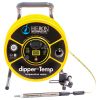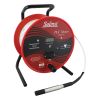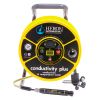Solinst Model 201 Water Level Temperature Meters
Features
- Accurately measure temperature from -20ºC to +125ºC
- Corrosion and chemical-resistant PVDF flat tape
- Standard 9V alkaline battery gives 90 hours of use
- Free ground shipping
- Expedited repair and warranty service
- Lifetime technical support
- More
Overview
The Model 201 Water Level Temperature (WLT) Meter is ideal for measuring static water levels, as well as profiling temperature in wells, boreholes, tanks and open water. Accurate temperature measurements are clearly displayed on an LCD readout on the faceplate, from -20ºC to +125ºC. Water level and probe depth measurements are read off the Solinst durable PVDF flat tape. Tape lengths are available up to 1000 ft (300m).
High-Quality Materials
The 201 Probe is made of high quality 316 stainless steel. The pressure-proof probe can be submerged to 1000 ft (300m). The zero measurement point on the probe is close to the tip, keeping water displacement at a minimum. The temperature sensor is located at the stainless steel tip of the probe, however, since the probe body acts as a heat sink, best accuracy is obtained when the probe is completely submerged. The tape seal plug design allows the probe to be easily replaced, if required.
The WLT Meter uses extremely durable PVDF flat tape. The tape is non-stretch and has a dog bone design that prevents adherence to wet surfaces. The tape reels smoothly, remains flexible and hangs straight, regardless of temperature. It is also easy to repair and splice. The 3/8" (10mm) wide tape has permanent laser markings every 1/100 ft. or each millimeter, traceable to NIST and EU measurement standards.
Operation
When the meter is turned on, the LCD screen displays the firmware version of the WLT Meter (e.g. “WLTM 1.0”) for about two seconds. The LCD will then display the temperature reading, in or out of water. The LCD menu is simple to operate. Pressing the button two times quickly deactivates the buzzer (the light stays active). To reactivate, press the button two times quickly. To turn the meter off, press and hold the button for two seconds.
When the zero point of the 201 Probe enters water, an electric circuit is completed, activating the buzzer and light. The depth to water is then read off the flat tape. Temperature readings are read off the LCD display. As the probe is lowered to take temperature measurements at discrete depths, the buzzer can be turned off by pressing the button two times quickly. This is ideal when profiling temperature.
In The News
Wildfire Prevention in the Sierra Nevada Region with the Yuba Watershed Institute
Though recent wildfires have sparked new conversations about wildfire management and response, groups like the Yuba Watershed Institute have been monitoring the forests and water resources of the Sierra Nevada region for decades, managing approximately 5,000 acres of land with the Bureau of Land Management (BLM) and about 7,000 acres in private land partnerships. The goal of the Institute is to work with local communities and land agencies to improve watershed and forestry management through informed practices and public outreach. The goals of the Yuba Watershed Institute are three-fold: Improve the ability of fire suppression agencies like the California Department of Forestry and Fire Protection ( CAL FIRE ) and the US Forest Service.
Read MoreWave Sensors Integration with NexSens Buoys: A Cutting-Edge Solution for Wave Measurment
Real-time wave data supports accurate weather prediction, safe and efficient maritime operations, and provides valuable safety and operating condition information for recreation and commercial fishing. Understanding wave dynamics also helps with the design of protective coastal structures like seawalls, breakwaters, and jetties. It also supports better prediction of their impact on sediment transport and coastal geomorphology. Wave data is a key factor in qualifying and designing offshore wind farms and harnessing kinetic energy for electrical generation. It helps with the understanding of ocean-atmosphere interactions and contributes to studies of sea-level rise and climate change impacts.
Read MoreSpring 2025 Environmental Monitor Available Now
In the Spring 2025 edition of the Environmental Monitor, we highlight partnerships across the world and the importance of collaboration between government agencies, universities, environmental groups, local communities, and other stakeholders. From great white shark research in Cape Cod to monitoring fisheries in Lake Erie, this latest edition underscores partnerships that connect stakeholders in a watershed through environmental data. With an emphasis on data sharing, a combination of real-time and discrete sampling keeps the public and partners informed of environmental conditions. Our writers also sought out science professionals dedicated to working with peers within and outside of the environmental sector.
Read More

























